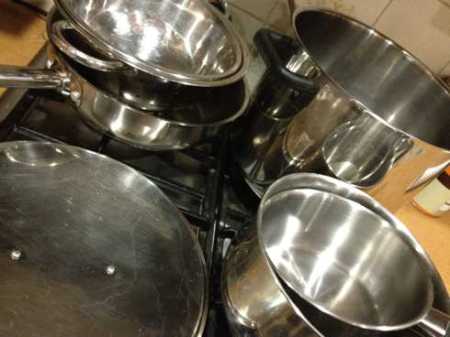
Some pots and pans made from Stainless Steel. We have become accustomed to the idea that steel does not rust, but this really an amazing achievement.
I had just washed the pots and pans and left them to drain when it struck me: my pots and pans never rusted. Even though they were made mainly of iron, and even though I routinely exposed them to boiling, salty water and flames, there was not a single spot of rust on any of my pans. They were – literally – stainless.
Like many miracles, ‘stainless’ steel is really engineering in action. Although now commonplace, stainless steel was once a wonder to behold. As the understanding of how to make steel ‘stainless’ grew at the start of the twentieth century. it provided yet more evidence of the unstoppable advance of technology. Rust – once the inevitable and unwelcome partner of steel and iron – had been vanquished.
Iron is an element with fascinating structural and magnetic properties, but steel is not a single substance. ‘Steel’ is a generic term describing a vast array of alloys. And even specifying ‘Stainless Steel’ only narrows down the range of alloys a little. There are thousands of steel alloys which are effectively ‘stainless’.
To make ‘steel’ into ‘stainless’ steel’ one generally adds around 14% chromium, but other recipes use vanadium and nickel. However, all the many different recipes for stainless steel use the same trick to make the steel ‘stainless’. The additive doesn’t alter the bulk properties of the steel too much, but instead alters the properties of the oxide that grows on the surface of every piece of metal.
The reason that steel corrodes is because the iron oxide which forms on its surface crumbles easily. This surface layer offers no protection to the steel underneath, and water and oxygen can work their way through the crumbly layer to eventually turn an entire piece of steel to iron oxide – rust.
Chromium oxide is much harder than iron oxide and it sticks to the surface of the metal more strongly. In stainless steel it is this the strong oxide layer that prevents oxygen and water slowly inveigling their way into the metal and causing it to crumble into rust. Although the surface layer is hard, it is thin – so thin it is transparent – and so we can see the metal underneath.
So it is the surface of stainless steel which is special. Indeed it is the surface layers that are important for other metals that we think of as resistive to corrosion: titanium and aluminium [but not apparently platinum or gold according commenter ‘bob’ – I am investigating]. If you take away the surface oxides from these normally inert metals, one finds extremely reactive chemistry. In fact it is the strength of their reaction with oxygen that makes the oxide so stable.
My sensitivity to the stability of surface layers on metals had been heightened by a traumatic event at work. My colleagues and I had built a new apparatus which we hoped would work up to 1000 °C. Our first version had been made of stainless steel and copper, but despite being robust at 100 °C, even ‘stainless’ steel had corroded badly above 600 °C.
So we had made a version made out of titanium and copper. We knew the copper would blacken as it oxidised, but we knew that copper wouldn’t melt until 1084 °C. We expected the titanium to be stable because its oxide – the pigment that makes white paint ‘white’ – is very stable, and titanium itself doesn’t melt until 1668 °C.
And indeed the device worked perfectly. Well it worked up to 900 °C, and then it melted. Melted? Dismantling the apparatus we found ‘blobs’ of metal and there was no doubt that it had melted. But how? After searching through journals, and with the benefit of hindsight we quickly learned how! We learned that copper oxide which forms on the surface of copper reacts with titanium oxide on the surface of titanium to make a mixture which melts at 919 °C – something we never would have imagined possible. It was the surface layers which dominated the properties of these metals!
So please, the next time you hold a teaspoon in hands, reflect on the brightness of your reflection, and the miracle of an invisible surface layer of chromium oxide, that prevents your image from tarnishing.
Tags: Stainless Steel
May 7, 2012 at 10:13 am |
“platinum, gold, titanium and aluminium. If you take away the surface oxides from these normally inert metals, one finds extremely reactive chemistry. In fact it is the strength of their reaction with oxygen that makes the oxide so stable.”
Titanium and aluminium form passive oxides, but not platinum or gold. If you can persuade them to oxidise, they’ll decompose back to metal with gentle heating. Anything but stable.
May 7, 2012 at 2:02 pm |
Mmmm. Is that really so? I am familiar with the strange fact that for silver at its melting temperature silver oxide is unstable on the surface of silver, and so molten silver stays clean.
Are you saying a similar effect is in action on the surface of gold or platinum?
May 7, 2012 at 2:46 pm
I should say my comment isn’t from any place of deep insight – I’ve simply never heard of platinum or gold having surface oxide layers. I always thought of them as clean metal surfaces. The formation reactions such as 4Au + 3O2 –> 2Au2O3 entail an increase in free energy, so I don’t see why any oxides would present on the surface at all, unless someone goes out of their way to deliberately create them. If this view is naïve in some way then I’d be curious to know more.